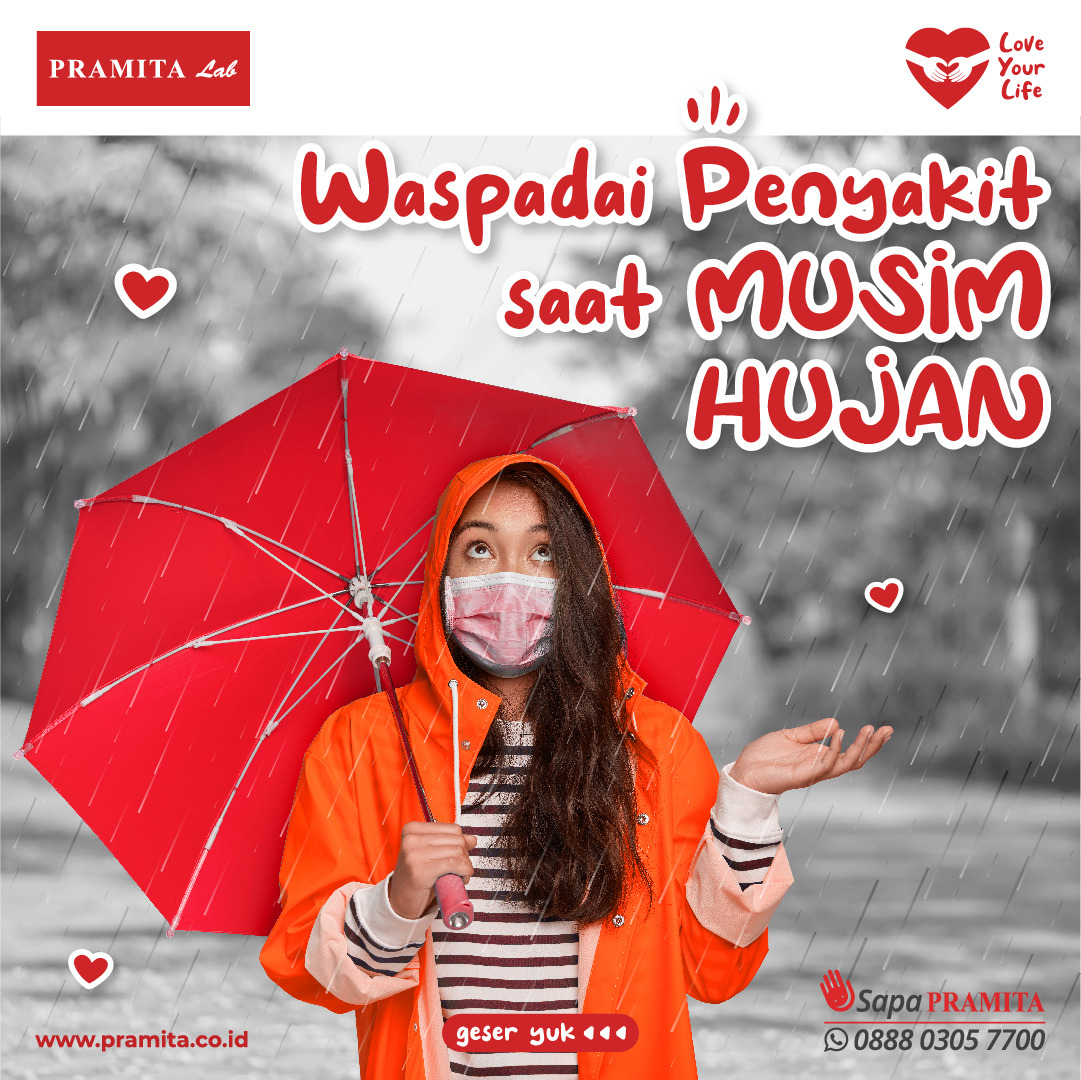Healthy Inspirations
Semua
Work Life
INFO PEMERIKSAAN
Parenting/Kesehatan Anak
LabPedia
Life Style
Kesehatan Wanita
Health Info
Millenial
Info Kesehatan
Mitos/Fakta

BEWARE OF DISEASES DURING THE RAIN SEASON
Wed, 28 Dec 2022
Climate change causes many environmental problems. The phenomenon of ice at the poles of the earth melts which causes the water level to rise causing flooding. Extreme weather such as heavy rains that occur continuously will cause flooding if the land is not ready to accommodate a large amount of water. Flood conditions make the environment dirty and become a nest for disease-spreading insects/mosquitoes to live and reproduce. With conditions like this, several diseases, including dengue hemorrhagic fever, will be very much.
By recognizing various common diseases that usually occur in the rainy season, this will make us more alert and better prepared in handling and preventing them.
Types of Diseases that Often Appear in the Rainy Season:
1. ISPA
This disease is caused by a virus or bacteria that attacks the respiratory system. ISPA is a common condition in the rainy season. However, complications from ARI can trigger pneumonia and this can be deadly. Children, the elderly, patients with chronic illnesses and those with weakened immune systems or taking immunosuppressive drugs are at risk for complications from ARI.
2. Diarrhea
The disease often occurs during the rainy season due to consuming possibly contaminated food or water. Symptoms of diarrhea are loose and liquid stools, fever or stomach cramps. To prevent diarrhea, eat cooked and steamed food, use a spoon when eating, wash your hands frequently and never use other people's cutlery.
3. Dengue Hemorrhagic Fever
This disease is caused by the Aedes aegypti mosquito, which likes water and humidity. The first stage of dengue fever symptoms is 2-7 days of fever and muscle aches. After that, the fever will go down. Hands and feet will be cold. Shock can occur in some people who have complications. As a preventive measure, we can avoid mosquito-infested areas, use insect repellent and sleep in mosquito nets. In the rainy season, we also need to maintain our health by getting enough sleep, consuming healthy food, exercising regularly to protect ourselves in the long term.
4. Typhoid fever
Poor sanitation can make diseases such as typhoid appear more frequently. Abdominal pain, constipation, diarrhea and headaches are symptoms that are often experienced by people with typhoid fever. This disease is caused by the bacterium Salmonella typhi which contaminates food and drinks. Other common symptoms are fatigue, muscle aches, excessive sweating, dry cough, skin rashes, loss of appetite and drastic weight loss.
5. Leptospirosis
Leptospirosis is a disease caused by Leptospira bacteria. This bacterium can spread through the urine or blood of infected animals. Some animals that can become intermediaries for the spread of leptospirosis are rats, cows, dogs and pigs. Symptoms of leptospirosis infection include fever, headache, muscle aches, especially in the calves and thighs, and vomiting. In some cases, symptoms can be severe including meningitis, liver and kidney damage or even death.
Author : dr. Luh Ayu Krisnayanti Darma (Consultant Medical Doctor for PRAMITA Clinical Laboratory Jl. Pajajaran No. 86 Bandung)
By recognizing various common diseases that usually occur in the rainy season, this will make us more alert and better prepared in handling and preventing them.
Types of Diseases that Often Appear in the Rainy Season:
1. ISPA
This disease is caused by a virus or bacteria that attacks the respiratory system. ISPA is a common condition in the rainy season. However, complications from ARI can trigger pneumonia and this can be deadly. Children, the elderly, patients with chronic illnesses and those with weakened immune systems or taking immunosuppressive drugs are at risk for complications from ARI.
2. Diarrhea
The disease often occurs during the rainy season due to consuming possibly contaminated food or water. Symptoms of diarrhea are loose and liquid stools, fever or stomach cramps. To prevent diarrhea, eat cooked and steamed food, use a spoon when eating, wash your hands frequently and never use other people's cutlery.
3. Dengue Hemorrhagic Fever
This disease is caused by the Aedes aegypti mosquito, which likes water and humidity. The first stage of dengue fever symptoms is 2-7 days of fever and muscle aches. After that, the fever will go down. Hands and feet will be cold. Shock can occur in some people who have complications. As a preventive measure, we can avoid mosquito-infested areas, use insect repellent and sleep in mosquito nets. In the rainy season, we also need to maintain our health by getting enough sleep, consuming healthy food, exercising regularly to protect ourselves in the long term.
4. Typhoid fever
Poor sanitation can make diseases such as typhoid appear more frequently. Abdominal pain, constipation, diarrhea and headaches are symptoms that are often experienced by people with typhoid fever. This disease is caused by the bacterium Salmonella typhi which contaminates food and drinks. Other common symptoms are fatigue, muscle aches, excessive sweating, dry cough, skin rashes, loss of appetite and drastic weight loss.
5. Leptospirosis
Leptospirosis is a disease caused by Leptospira bacteria. This bacterium can spread through the urine or blood of infected animals. Some animals that can become intermediaries for the spread of leptospirosis are rats, cows, dogs and pigs. Symptoms of leptospirosis infection include fever, headache, muscle aches, especially in the calves and thighs, and vomiting. In some cases, symptoms can be severe including meningitis, liver and kidney damage or even death.
Author : dr. Luh Ayu Krisnayanti Darma (Consultant Medical Doctor for PRAMITA Clinical Laboratory Jl. Pajajaran No. 86 Bandung)

